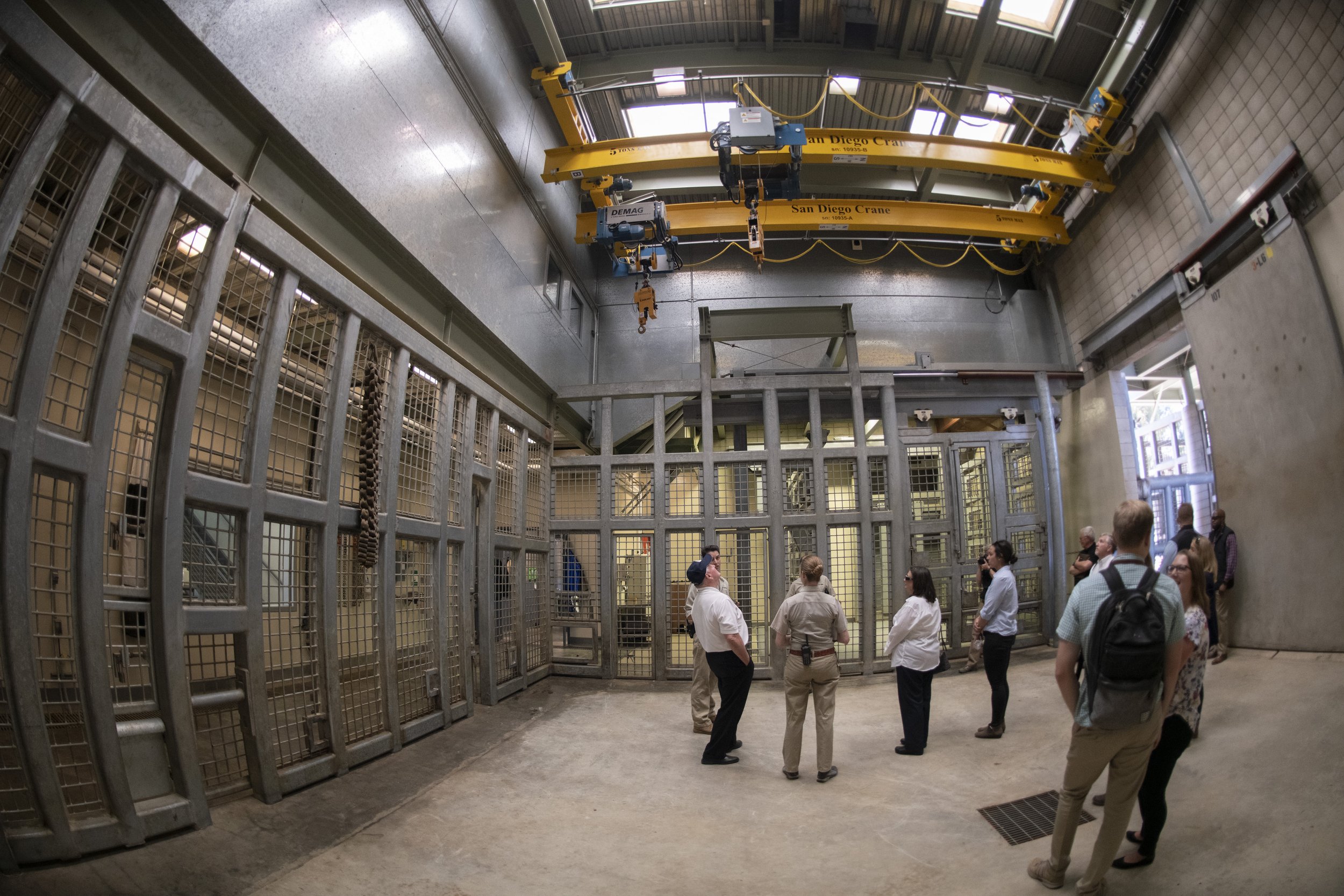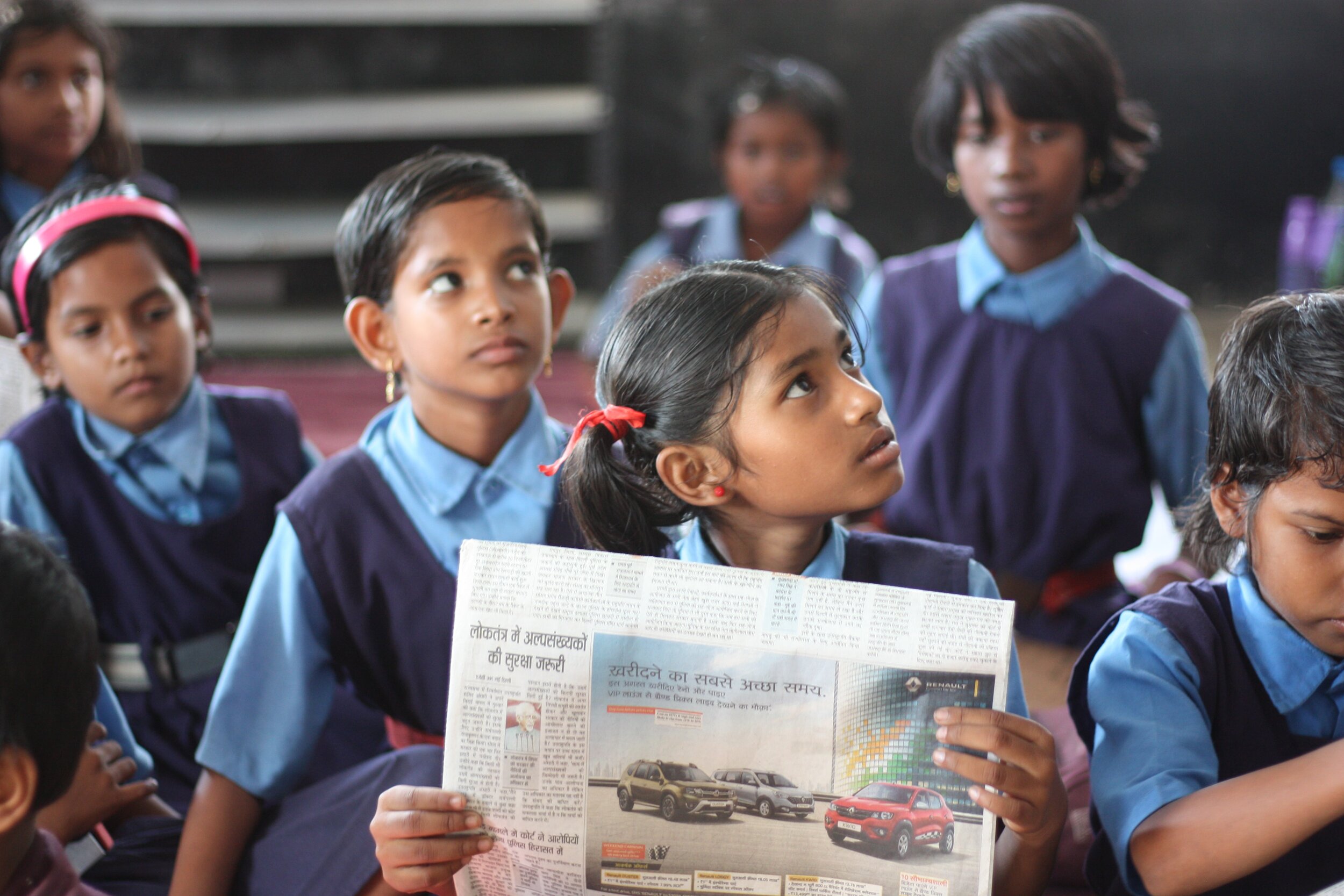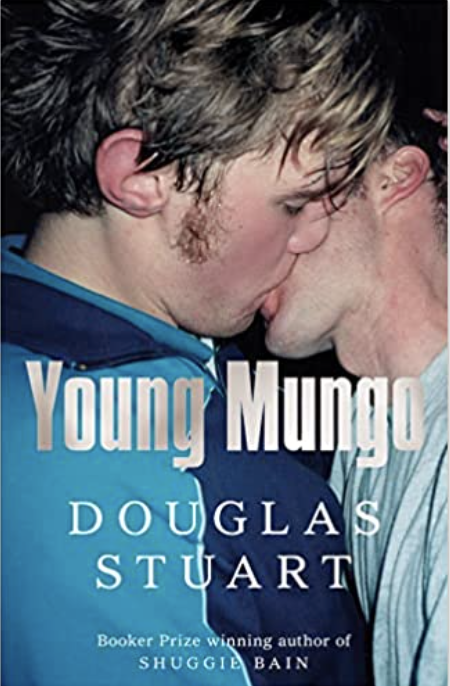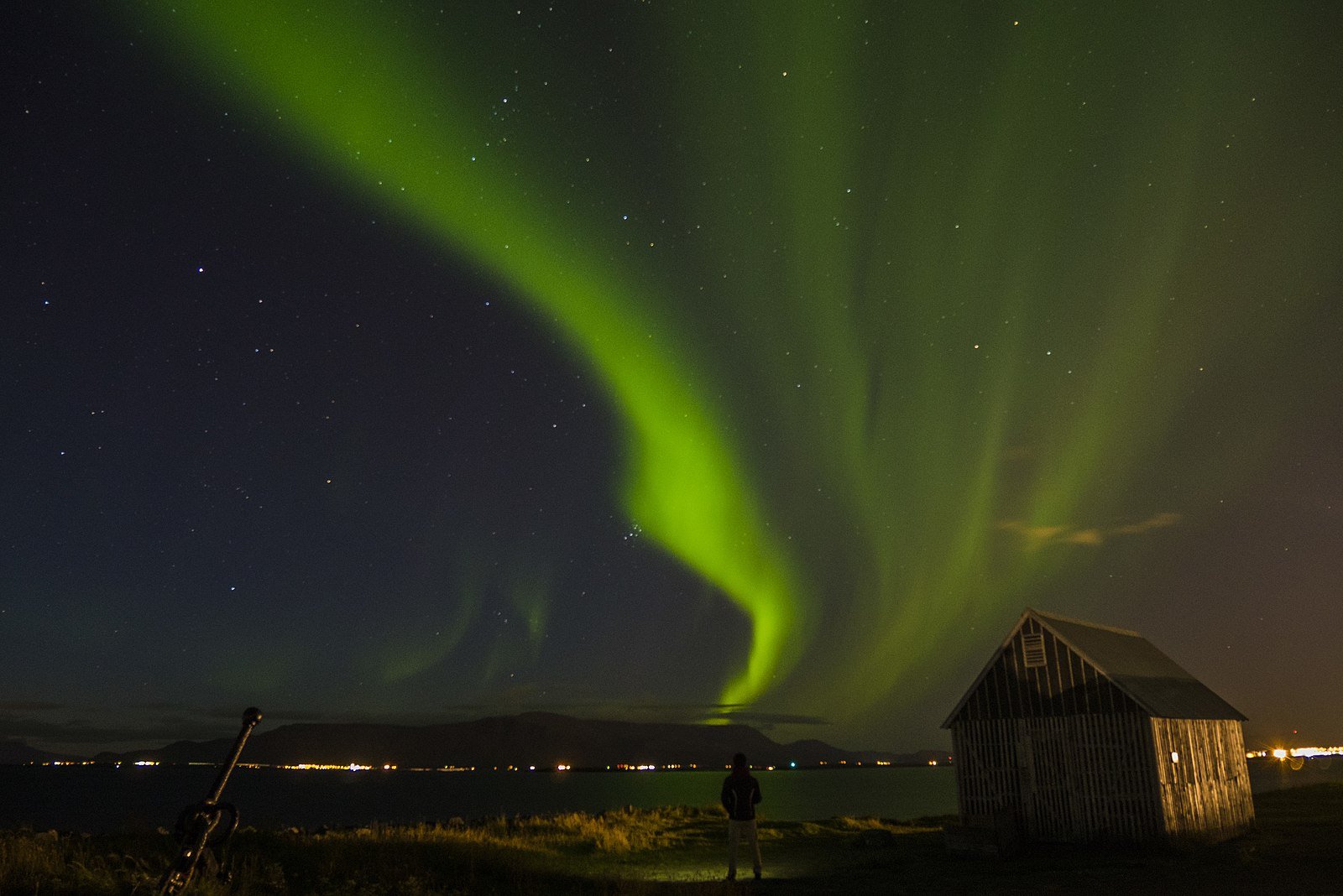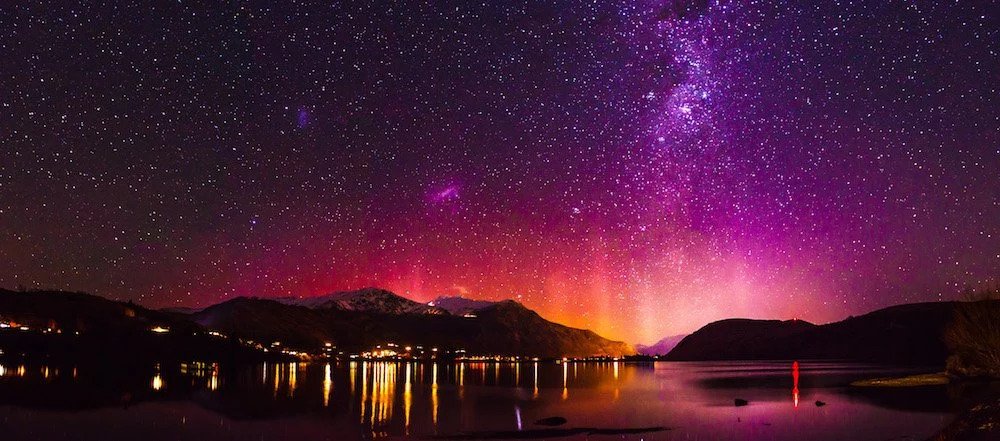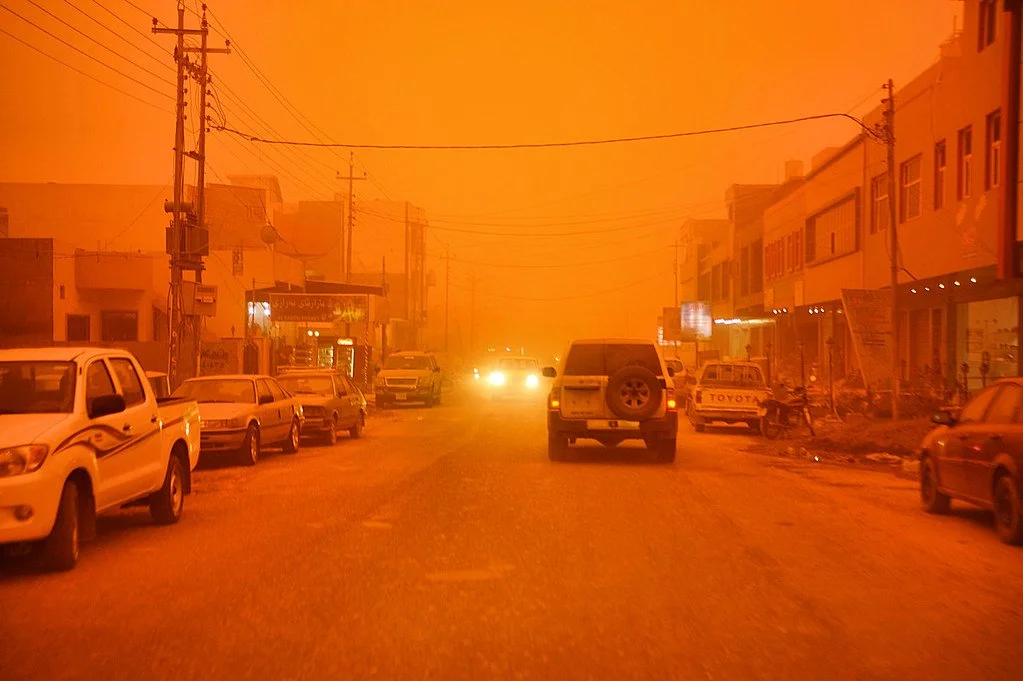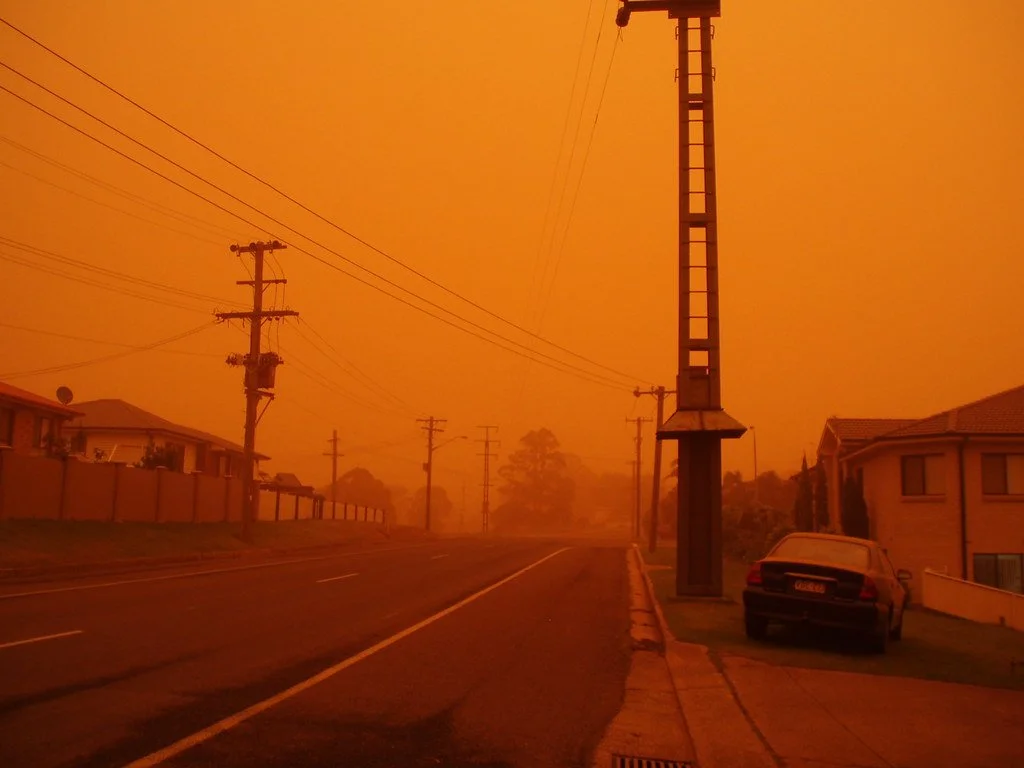For the past 600 years, dancers in Papantla, Mexico, have taken to the skies to perform the acrobatic spectacle, the Danza de los Voladores (Dance of the Flyers). Four flyers and one guide dressed in vibrant colors ascend a 20-meter pole, anchored only by a single rope tied to their legs. There, they begin the ritual, flying through the air to ask the sun deity for rain and blessings.
Frozen Zoos Might Be The Key to Saving Dying Species
The San Diego Frozen Zoo is the largest collection of animal gene samples in the world, and might be the answer to saving endangered animals from extinction.
A collection of vials containing gene samples from different species of animals. San Diego Zoo. CC BY-NC-ND 2.0.
Although the San Diego Zoo regularly receives a few million visitors every year, very few, if any at all, are aware of a collection much larger than the one on public display. Diligently maintained by a team of dedicated scientists and researchers, the San Diego Frozen Zoo houses gene samples from over 10,000 individual animals, all being preserved in the hopes that they will be able to help resurrect the rapidly dwindling populations of many at-risk species. It is the largest and most diverse collection of its kind in the world, and even includes a sample from the extinct po’ouli bird that vanished in 1988.
This ingenious strategy of species conservation can be traced back to the work of the German-American pathologist and geneticist Kurt Benirschke. He began his collection of skin samples from rare and endangered animals back in 1972 while working as a researcher with the University of California San Diego, and he quickly grew it into the very first cryobank of its kind at the San Diego Zoo. While Benirschke unfortunately passed away in 2018, his legacy is still very much alive in the continuing efforts of the growing team of scientists at the Frozen Zoo, who contribute their expertise on everything from recovery ecology and biodiversity banking to population sustainability and disease investigations.
Kurt Benirschke, the late scientist and founder of the San Diego Frozen Zoo. San Diego Zoo. CC BY-NC-ND 2.0.
Using cutting edge in vitro fertilization technologies, the Frozen Zoo has made huge strides towards developing a sustainable procedure, using artificially inseminating sperm that has been frozen for extended periods of time to produce viable offspring. Early attempts saw the successful development of cheetah and white rhino embryos in the lab, as well as the birth of chicks from a number of pheasant species, all from cryopreserved sperm. Perfecting this method would allow scientists to increase populations of rare and endangered species by introducing animals delivered in vitro back into the wild.
Another strategy the Frozen Zoo is looking into involves the genetic cloning of endangered species using the frozen genetic material in their collection. Since 2001, the zoo has cloned the Black-Footed Ferret, the Indian Gaur (an Asian humpbacked ox), the Banteng (a Southeast Asian species of cattle) and Przewalski’s Horse (a species from Mongolia that was extinct in the wild until not long ago). While their cloning process is still very much in the works, any advances in this type of cloning and genome sequencing can also be used to better understand the biology of endangered species in the wild and help with current conservation efforts.
Scientists from the Frozen Zoo successfully cloned a wild horse (center) believed to be extinct in the wild using cryopreserved sperm. Tanya Durrant. CC BY-ND 2.0.
One of the zoo’s most recent projects has a slightly different focus: they are putting together a database of unique barcodes to help identify species of primates and deer being transported as part of the illegal bushmeat trade. Another recent collaboration with The Scripps Research Institute involves members of the zoo’s Reproductive Sciences and Conservation Genetics teams looking for new state of the art stem cell technologies that could help to revive the critically endangered Northern White Rhino. This collaboration is also just the first step in the zoo’s goal to create a worldwide network of similar cryobanks, which will share knowledge and resources to continue developing an even more diverse bank of genetic material in support of species conservation.
The Frozen Zoo stores thousands of samples of genetic materials in their cryobank. US Department of Agriculture. CC0.
For those interested in getting involved, the zoo runs a number of educational opportunities for high school and college students in the form of fellowships, internships and externships, as well as a master’s degree program in conjunction with Miami University, Ohio. They also have a regular schedule of seminars run by various experts in the field which are open to the public.
Tanaya Vohra
Tanaya is an undergraduate student pursuing a major in Public Health at the University of Chicago. She's lived in Asia, Europe and North America and wants to share her love of travel and exploring new cultures through her writing.
The Island of Sardinia
Located off the western coast of Italy, Sardinia is a beautiful island well known for its history, beaches, rock formations and caves.
Porto Giunco in Sardinia. Tjshot. CC BY-NC-SA 2.0.
Among all the islands in the Mediterranean Sea, the two largest ones belong to Italy. Sicily is the largest and one of the most well-known for its beauty, but Sardinia, the second largest, is equally beautiful. Like the rest of Italy, it has its own rich history that goes back thousands of years that stretches back before the Roman Empire. Beyond that, the island is known for its beaches and rock formations, but apart from the coastline, the island is also very mountainous. Its highest point, Mount La Marmora, stands at 6,017 feet (1834 m).
One of the most distinctive features of Sardinia are the nuraghes, which are small buildings built in the prehistoric times. There are no records of the people who built and lived in them, but archeological evidence seems to suggest that whoever lived there had an organized tribal system. The Phoenicians came to the island because of the mines, but it eventually passed into Roman rule. Since then, the island has been under the control of many nations. Because of that, Sardinia also has a unique Italian dialect known as Sardu. Interestingly enough, most Italians do not understand the Sardinian dialect and it sounds closer to Spanish than Italian. The language is also very articulate, so in the past, Italians considered it barbaric in comparison to their much softer sounding Italian.
Many ruins from the past are found on Sardinia. The nuraghi are scattered across the island, as are other ancient settlements and towers dating back to the Bronze Age. There are also tombs known as tombe dei giganti, or tombs of the giants, and domus de janas, or fairy houses tombs. But beyond the ancient history, Sardinia’s beaches are also major attractions for the island. They are long and white, often compared to the beaches in the Caribbean, and they regularly make the polls for the best beaches in the world. Is Aruttas, Spiaggia di Piscinas, Spiaggia Rena Bianca and La Maddalena are some of the most popular beaches on the island. Near the sea, too, are the rock formations. Capo Testa is a popular spot to see them. It is near the water but as they are rocks, it requires some hiking, and it does not have the long stretches of white sand. Wind from the Mediterranean has smoothened the rocks over thousands of years, and it has been powerful and persistent enough to shape some of them, which is why the rocks at Capo Testa have such interesting forms. Lastly, the grottos across Sardinia are as equally beautiful and impressive as the beaches and rock formations. There are dozens of caves beneath the island and many are accessible for tourists to visit. The Grotto di Nettuno is one of the most famous caves, and inside it lies an entire lake and large stalactites. Another impressive cave is Grotto Verde, literally translated to “Green Cave”, because of the moss that grows along the stalactites, turning it green.
Grotto di Nettuno. Klaus Nahr. CC BY-SA 2.0.
Like every region in Italy, Sardinia has its own food culture. They do have their own pasta specialities, like malloreddus that is made in a curved shape in order to better catch sauce and cheese. This particular type of pasta is eaten with a sauce called Campidanese and it is made up of saffron, sausages with fennel seeds, tomatoes and Pecorino cheese. In fact, Pecorino cheese originated from Sardinia. It is very popular and goes with many pasta dishes or melted in a sandwich.
Of course, since Sardinia is an island, they are also known for their seafood. Their seafood pasta, fregola ai frutti di mare, is interesting because the noodles are cooked like a risotto. Sardinians also love sea urchins, so much so that they hold sea urchin festivals. The sea urchins are commonly eaten with spaghetti, but the festivals also serve other seafood such as swordfish, tuna carpaccio and fried fish.
Katherine Lim
Katherine Lim is an undergraduate student at Vassar College studying English literature and Italian. She loves both reading and writing, and she hopes to pursue both in the future. With a passion for travel and nature, she wants to experience more of the world and everything it has to offer.
As education increases, more women in rural areas are able to access schooling. Here, young girls in India’s Chhattisgarh state attend government school in their uniforms. Jaikishan Patel. Unsplash.
The Gender Education Gap is Narrowing. Here’s How You Can Help Close It
More girls are enrolling in education than ever before, and the gap between educated women in men is narrowing. Based on a report given by UNESCO, 180 million more girls have enrolled in primary and secondary education since the Beijing Declaration and Platform for Action, a commitment signed in 1995 by 189 countries in which they pledged to advance the rights of girls and women. The report shows that the global enrollment rate for girls in school increased from 73% to 89%, and the biggest improvements are seen in sub-Saharan Africa and South Asia, especially in India. The reasons behind this inequality are historical, social and economic, as barriers like poverty and rigid gender roles place large burdens on accessing schooling.
Young men and women studying in the classroom in Klaten, Indonesia. Husniati Salma. Unsplash.
This push for women’s education did not stop at the primary level, with three times more women enrolling in universities than 25 years ago, and the most significant progress is seen in North Africa and Western Asia. Morocco has particularly excelled, reaching enrollment parity in 2017 after more than 20 years of the rate of enrollment being just 30 women for every 100 men. The report found that although women are present in the classroom more frequently, there is still a culture of dismissal revolving around women’s education, so the efforts toward educating women are now focusing on representation and validation.
Ways You Can Get Involved:
In relation to the report, a personal way to involve yourself is to participate in the #Iamthe1stGirl campaign, started by the Global Education Monitoring (GEM) sector of UNESCO. This campaign asks women and girls who were the first of their family to graduate from high school and/or university to share their own stories of education and success. By sharing your own story, you can inspire women and girls to continue fighting for their right to be educated. The stories have been shared on Instagram and Twitter by the GEM account, and while the campaign did not go viral, the social media interactions show girls being inspired to continue their education in real time.
There are several ways to get involved financially, and most involve the direct sponsoring of a woman in the process of getting her education. World Vision has a simple and effective sponsoring process, and your money goes toward not only providing school supplies, but also ensuring that proper sanitation and transportation is offered to women at school.
Malala Yousafzai speaking on the creation of a shared future through education and empowerment. World Economic Forum. CC BY-NC-SA 2.0.
A fund with a story you may be familiar with is the Malala Fund, started by Pakistani girls’ education activist Malala Yousafzai in 2013 “to champion every girl’s right to 12 years of free, safe, quality education.” The money in the fund goes toward their board along with the leadership council and staff, championing “the creation of a more equal world by making sure all girls can go to school.”
On a smaller scale, you can ensure the girls and women in your community do not face barriers to their education by creating or participating in school supply and sanitary product drives and by sharing your own story about education.
Donations collected during a 2015 school supply drive in Tallahassee, Florida. flguardian2. CC BY-NC-SA 2.0.
There are several ways to get involved in closing the gap. To donate towards causes that sponsor women’s education through providing instructors and supplies, you can visit World Vision or Malala.org.
In order to make sure that menstruation does not interfere with learning, you can donate money and time to several organizations that supply period products like, DoSomething.org. Two other organizations that also supply products are, DayForGirls.org and BintiPeriod.org. Days for girls is a women’s equality organization so it provides other avenues of involvement as well.
To donate school supplies you can visit, Kinf.org to help students in the United States. Another school supply organization, Classroom Central, finds local schools in need of donations. For international involvement, you can directly donate to UNICEF USA.
For those who want to learn more information and sign petitions, Plan International provides both on their website, Plan International. Another petition to sign can be found on One.org where you can pledge to support the closing of the gender education gap. Lastly, you can even start your own fundraiser for school supplies and education funding at Room to Read.
Renee Richardson
Renee is currently an English student at The University of Georgia. She lives in Ellijay, Georgia, a small mountain town in the middle of Appalachia. A passionate writer, she is inspired often by her hikes along the Appalachian trail and her efforts to fight for equality across all spectrums. She hopes to further her passion as a writer into a flourishing career that positively impacts others.
CATALYST Fall Reading List: Top 10 Books
Now that beach reads are back on the shelves, it’s time to cozy up with these fall titles. CATALYST provides ten of the hottest books right now to add to your bookshelf.
Finish your summer reading? Good, because CATALYST’s lineup of new books for the fall provides wondrous worlds to explore, without leaving the comfort of your favorite reading chair. From elegiac poetry to bracing memoir to transgenerational fiction, this list offers a diverse array of books that comprise a who’s who and what’s what of the literary world today. From some of literature’s biggest names to lesser-known geniuses, these books promise to widen your scope of what books can accomplish–and of where they can take you.
1. Young MungoDouglas Stuart
Douglas Stuart follows his worldwide sensation “Shuggie Bain” with this tender, brutal novel of young working-class love between two young men. Mungo and James are born on opposite factions of a sectarian divide- Mungo on the Protestant side and James on the Catholic side. Despite their differences, however, they forge a friendship – and something more – that simultaneously threatens life as they know it but promises to change it for the better. This heartbreaking novel ends with a search for both inner and outer peace that provokes thought as much as it does tears.
Colson Whitehead takes his reader back in time with his latest outing. “Harlem Shuffle” tells the story of the scrappy social climber Ray Carney, full-time furniture salesman and part-time crook, as he learns the true rules and rulers of his beloved New York City. When he takes part in a heist of Harlem’s most esteemed hotel, he puts his whole life in jeopardy. In lavish prose, Whitehead paints a vivid picture of Harlem in the 1960’s such that his novel becomes a love letter to a bygone era. But will Ray Carney be able to survive the twists and double-crosses that comprise his life-story and make it to the better neighborhood he has always dreamed of?
What do you get when you mix an audacious heist, a biting social commentary and a moving love story? You get Rahul Raina’s “How to Kidnap the Rich”. This hilariously chaotic novel follows Ramesh Kumar, a brilliant yet impoverished young man who serves India’s upper-class by acing SAT tests for children. When his client Rudi Saxena places first in the national university entrance exams, he seeks to capitalize on his success, only for both of them to be kidnapped. What follows is a thrilling page-turner replete with caustic barbs against India’s upper-class. A searing, incendiary novel, “How to Kidnap the Rich” will surely captivate any reader who delights in double-crosses and thought-provoking satire.
Living at the intersection of blackness and queerness, George M. Johnson is uniquely situated to perceive the injustices faced by queer Black youth. Perhaps that is why he wrote “All Boys Aren’t Blue” as a series of essays designed to advise and guide young adults, though the book’s messages resonate for readers of all ages. From being bullied as a young child, to his first sexual experiences, to the support network that saw him through his life’s worst travails, this book covers territory from which most authors shy away, but ultimately in the service of love, Johnson seeks to confront this territory. In telling his story, Johnson provides reader’s a mirror in which they can see themselves reflected. Hopefully, they will also see, as Johnson ultimately did, a path towards healing.
This graphic novel explores the ambiguities of gender and sexuality, which is experienced at a young age in a political moment defined by anti-LGBTQ+ backlash. “Gender Queer” is the most banned book in the United States, according to the New York Times, thanks to conservative activist movements that object to its frank depictions of gender dysphoria, sex and sexuality. At heart, it is a compelling story of Maia Kobabe’s quest towards self-discovery as a non-binary person. Its gorgeous images and thoughtful meditations are the best alternative to a public debate around gender that grows more raucous by the day.
From blue-bearded millionaires to ravenous wolves, the women of “How to Be Eaten” have survived some of fairy tales’ most devilish, nefarious men. Adelmann’s second book and first novel follows the female characters of some of the Brothers Grimm’s most famous yarns as they attend a trauma therapy group, where they process the immense harm done to them by their male counterparts. By turns wicked and uplifting, this book ultimately indicts the reader’s craving for a clear-cut happy ending. Sadly, love in Adelmann’s telling is not as easy as the Brothers Grimm would have us believe.
Famed Nobel Prize winner Kazuo Ishiguro turns his incisive, writerly gaze to the sci-fi genre with “Klara and the Sun”. Lonesome yet insightful, Klara is a robot who watches the world pass by from her perspective in a shop that dispenses Artificial Friends. When her life stands to change forever, she finds that her hopes may have been misleading her all along. Told in Ishiguro’s subtle and revelatory voice, “Klara and the Sun” is an accomplished addition to the author’s already impressive body of work.
Author Iain Sinclair is famous for pushing and obscuring the boundaries between different media. In this book, he uses his multidisciplinary approach in the service of nonfiction. “The Gold Machine” relays his travels with his daughter through Peru following the trail of his great-grandfather. What he finds is the wreckage wrought by British colonialism and the still-open wounds of a country recovering from history. At once hypnotic and bracing, “The Gold Machine” charts colonialism’s legacy in the most personal of terms.
Ocean Vuong has catapulted poetry into the public spotlight with his arresting voice, palpable heart and his search for passion. He follows his autobiographical debut “On Earth We’re Briefly Gorgeous” with a second poetry collection, which continues the themes he has explored in his earlier poetry and fiction. Written in the wake of his mother’s death, Vuong captures the debilitating stagnation of grief but hints towards the means by which it is overcome. Inspiring, breathtaking and true, “Time Is a Mother” renews the reader’s faith in poetry to tell the heart’s most revealing secrets.
10. Homegoing Yaa Gyasi
As debut novels go, “Homegoing” is ambitious. It covers seven generations of a family’s history, tells that story from fourteen different perspectives and does it all in 300 pages. Despite the odds, the book soars. An almost impossibly moving novel about two sisters prohibited from knowing each other by the structures of British colonialism, Effie and Esi lead vastly different lives but are still in part defined by the racist eras they inhabit. From the Atlantic slave trade to the jazz clubs of Harlem, “Homegoing” captures the grief of the Ghanaian diaspora while illustarting the beauty and love that emerged from tragedy.
Michael McCarthy
Michael is the CATALYST book editor and curator. His fiction, nonfiction, interviews, and book reviews have appeared in The Adroit Journal, Barzakh Magazine, Beyond Queer Words, and Prairie Schooner, among others. Currently, he is transferring from Haverford College to University of Carlos III in Madrid, Spain, where he intends to major in the Humanities. He is also seeking publication for his poetry chapbook Steve: An Unexpected Gift, written in memory of his late uncle. He can be reached at @michaelmccarthy8026.
Chasing Aurora: Where To See The Northern Lights
From Norway to New Zealand, these five spots are perfect for experiencing the elusive beauty of the Aurora Borealis.
The Northern Lights as seen from the southern coast of Iceland. Cameron Pickett. CC BY 2.0.
The Aurora Borealis, better known as the Northern Lights, is one of the most magical natural phenomena to witness in person. It is caused by electrical interactions in the upper atmosphere that release waves of normally green and yellow light depending on which elements have reacted. Environmental conditions need to be perfect in order to properly experience the true beauty of the elusive lights, but there are a few locations near the Arctic Circle from which they are easier to spot. Here are five locations with an exceptionally good view for those who are trying to catch a glimpse of the lights, adjusted for the current astronomical layout of the planets and stars.
1. Rovaniemi, Finland
The Northern Lights shining down on the Santa Claus Village in Rovaniemi, Finland. Santa Claus Village. CC BY-NC-ND 2.0.
The city of Rovaniemi is the capital of Lapland, and is also well publicized as being the hometown of Santa Claus. Situated right on the Arctic Circle, it is most easily reachable by plane from Helsinki, though it is also accessible by local trains and buses. Rovaniemi is famous for its natural beauty -- its northern latitude makes it perfect for those wanting to experience the ‘midnight sun’ phenomenon, where our star is visible for a whole 24 hours. The city is the perfect destination for travelers looking to enjoy the Northern Lights, with the optimum viewing times occurring between August and April.
2. Yukon, Canada
The Northern Lights over Kluane Lake, Yukon. Keith Williams. CC BY-NC 2.0.
Located in the north east corner of Canada, the Yukon territory is home to almost 22,000 square kilometers (around 8,500 square miles) of protected land as part of the Kluane National Park and Reserve. Visitors can reach the park by plane, boat or car to visit the country’s largest ice field, an incredible grizzly bear population, and even Mount Logan, Canada’s highest peak, which stands just under 6,000 meters (around 19,685 feet) tall. While the Northern Lights can be seen from most of Canada’s provinces, the display is visible to those in the Yukon from August to April, making it one of the longest viewing seasons in the country.
3. Reykjavík, Iceland
The Northern Lights seen from a small cabin just outside of Reykjavík, Iceland. Davide Cantelli. CC0.
The Icelandic capital of Reykjavík is by far the largest city in the country and is also one of the best places to watch the Northern Lights. Just a few degrees south of the Arctic Circle, many residents of the city claim to see the display from their windows on especially bright nights. Visitors can fly directly into the city’s airport and enjoy various other outdoor activities including icy glacier hikes, swimming in natural hot springs during the day and venturing to Thingvellir National Park, which is just a short drive from the city to see the aurora. Though brighter auroras can be seen from the city, avoiding light pollution makes it much easier to experience the full display between September and April.
4. Tromsø, Norway
The Northern Lights shining over the mountains in Tromsø, Norway. Maria Wulff Hauglann. CC BY-NC 2.0.
Located in the heart of the northern aurora zone, the Norwegian city of Tromsø is most well-known for its view of the Northern Lights. Visitors can book one of the many available aurora tours hosted by guides who have expert knowledge of the best local sites from which to watch the display. Many of these base camps offer excellent viewing of the lights from September all the way till April. Tromsø is just a quick 3.5 hour flight from London for those wanting to experience the local Sami culture, or for those simply looking to indulge themselves in the city with the most bars per capita than any other in Norway.
5. Kiruna, Sweden
The Northern Lights as seen from the town of Kiruna in Swedish Lapland. Martin Eklund. CC0.
The wilderness of Swedish Lapland is perfect for those looking to enjoy the Northern Lights away from other tourists. Additionally, the complete lack of light pollution allows for a particularly vibrant viewing. As the northernmost city in Sweden, Kiruna is located well within the Arctic Circle and is home to the largest underground iron ore mine in the world. The town also neighbors Jukkasjärvi, a town made recently famous for its hotel made entirely of ice. Visitors who stay here can typically enjoy the lights between September and March, though the season can often begin slightly earlier and end slightly later.
Bonus: Queenstown, New Zealand
The Southern Lights captured near Queenstown, New Zealand. Bec Potter. CC BY-NC-ND 2.0.
This final destination highlights the resort town of Queenstown on New Zealand’s South Island. Unlike the other places on this list, it is a perfect place to experience the natural phenomena known as the Aurora Australis or the Southern Lights. This aurora is similarly caused by interactions between molecules in the upper atmosphere, which release waves of light across the night sky, though the Southern Lights tend to appear red and pink. This is due to the types of gas that are interacting and the atmospheric height at which the interactions take place. Visitors can fly straight into Queenstown’s international airport and enjoy the natural beauty of the nearby Lake Wakatipu during the day, before settling in to watch the display at night.
Tanaya Vohra
Tanaya is an undergraduate student pursuing a major in Public Health at the University of Chicago. She's lived in Asia, Europe and North America and wants to share her love of travel and exploring new cultures through her writing.
The Great Pacific Garbage Patch
In the middle of the Pacific Ocean, plastic debris gets caught in ocean currents that drag it all together, creating a massive island of trash double the size of Texas
Plastic from the Ocean. Kevin Krejci. CC BY 2.0
In the Pacific Ocean lie two massive islands of garbage, known as the Great Pacific Garbage Patch. The Western Garbage Patch is located near Japan, and the Eastern one is in the waters between Hawaii and California. Combined, both patches are estimated to span 1.6 million square kilometers (over 620,000 square miles). This is equivalent to twice the size of Texas, the second largest state in the United States in terms of land, and it is not even an exact measurement. Due to the fact that a lot of marine debris sinks to the ocean floor, the exact size of the patches is unknown. Trillions of pieces of plastic have all found their way into the ocean and were carried to these island patches by various ocean currents.
Washed up plastic. Fabi Fliervoet. CC BY-NC-ND 2.0.
Part of that problem is because much of the debris consists of microplastics, small pieces of plastic 5 millimeters or less that have flaked off from larger items. These microplastics are also easily ingested by fish and other marine life, which is absolutely damaging to them. The chemicals in the plastic will affect the animals, which can start affecting the food chain as the smaller ones get eaten, and it could eventually make its way up to humans. It is hard to determine the full extent of the effects of them in human bodies due to the fact that we don’t know how long microplastics stay in our bodies, but studies show microplastics harm cells. Microplastics are the most dangerous and harmful part of all the litter in the ocean due to these effects.
Besides humans, the litter in the ocean is harmful to marine life. There are turtles that ingest plastic bags, thinking they are jellyfish, birds that mistake some bits for fish eggs and feed it to their chicks, causing their organs to rupture and other sea animals that die of starvation because their stomach is full of plastic that has no nutrients. Beyond that, some plastics will release methane and ethylene when exposed to sunlight, both of which are greenhouse gasses that contribute to global warming. In addition, the microplastics affect the efficiency of photosynthesis in plankton, which in turn affects the ocean’s ability to absorb carbon dioxide in the atmosphere. Microplastic negatively impacts so many parts of life and the environment.
Cleaner beaches. Paul van de Velde. CC BY 2.0
To Get Involved
There are many organizations that fight plastic pollution in the ocean. As most plastic ends up in the ocean, a lot of them are focused on helping reduce the amount there, but there are organizations that aim to reduce the use of plastic in the world overall. For example, the Oceanic Society lowers plastic use by raising awareness of its effects, reducing usage in tourism practices and by supporting coastal communities. The Plastic Soup Foundation based in the Netherlands aims to prevent plastic from entering the environment in the first place. By sharing knowledge and monitoring research related to plastic pollution, the Plastic Soup Foundation educates people and formulates projects to aid in their goal. It also advocates for diminishing individual plastic usage and creating regulations and legislations for decreasing plastic.
To learn more about the Oceanic Society, click here.
To learn more about the Plastic Soup Foundation, click here.
To learn more about the Plastic Pollution Coalition, click here.
Katherine Lim
Katherine Lim is an undergraduate student at Vassar College studying English literature and Italian. She loves both reading and writing, and she hopes to pursue both in the future. With a passion for travel and nature, she wants to experience more of the world and everything it has to offer.
Dust Storms: Syria and Iraq’s Orange Skies
Syria and Iraq are experiencing dark orange skies due to an uptake in dust storms these past few months.
Orange dust air in Kurdistan. Lachica Photo. CC BY NC-ND 2.0.
Since March, the Middle East has been plagued with dust storms that have continued into early June. Accredited to climate change, these severe dust storms have been causing mass destruction around the Middle East, forcing the closing of schools and places of work, reducing the air quality over extended periods of time and even sending people to the hospital. With citizens unable to breathe outside their homes and damage being done to property and people, the Middle East is in a state of emergency.
The Middle East is a region familiar with dust storms. Dubbed “Shamal Winds”, the northern wind current that often rips through Middle Eastern areas like Iraq has sent storms to the area for decades. However, the instances taking place this year are said to be far too frequent compared to previous national averages, and climate change is to blame. Typically, the Middle East will face on average around 270 dust storms a year. The Ministry of Environment of Iraq believes that number is predicted to rise to around 300 storms by 2050.
Orange sky after dust storms. Kaptain Kobold. CC BY-NC-SA 2.0.
The main effects of climate change on both the frequency and severity of dust storms have been linked to drought and the “desertification” of large land masses. Dust storms frequently affect arid or semi-arid lands; arid lands describe lands that lack water and become exceptionally dry. The Middle East is experiencing a time of excessive drought and declining rainfall rates. Brookings Institute states that the Middle East is a region listed 12th out of 17 for the most water scarcity, and the rate of rainfalls in the region have declined over the last few decades.
These findings are heavily affecting the ability for northern currents like the Shamal Winds to pick up sand and dust particles from dry hot land, sending them sweeping across the skies of the Middle East. Because such large areas of the Middle East are drying out, strong currents are now able to pick up the dry sand and dust particles into the air, increasing not only the frequency of these dust storms because they are easier to create with progressively dry lands, but also increasing the severity due to particle-heavy air. These particles are also what create the dark orange tint to the air and sky.
Dust storm over the Middle East. Nasa Earth Observatory. CC BY 2.0.
With the air so packed with dust and sand, and with the temperatures rising as summer closes in, the Middle East is suffering. The air quality has now sent thousands to the hospital looking for reprieve from the unbreathable air, suffering from illnesses like asthma, breathing trouble and even lung congestion. Additionally, four deaths in Iraq and Syria have been attributed to the orange air.
As of June, The Weather Channel reported there had been more than 10 dust storms in both April and May, and The Guardian stated that Saudi Arabia had already experienced 35 dust storms in only the first four months of 2022. Scientists and climate activists alike are concerned with the way these dust storms have been ravaging the Middle East, and fear the far-reaching impacts of the severe natural weather.
The Dean of the School of Public Health at the University of Nevada spoke with The Guardian and stated that, “The impact of dust storms exceeds regional and continental boundaries,” making this problem something every country should be concerned about. Greatly linked to climate change and unconcerned with borders, dust storms may be an indication of what is to come for the rest of the globe with rising temperatures drying out massive areas of land.
Ava Mamary
Ava is an undergraduate student at the University of Illinois, double majoring in English and Communications. At school, she Web Writes about music for a student-run radio station. She is also an avid backpacker, which is where her passion for travel and the outdoors comes from. She is very passionate about social justice issues, specifically those involving women’s rights, and is excited to write content about social action across the globe.
The Most Endangered Species of Penguin
The yellow-eyed penguins of New Zealand are the rarest species of penguins in the world.
Group of Yellow-Eyed Penguins. Chris Gin. CC BY-NC-ND 2.0
Known as hoiho penguins in the Māori language of New Zealand, yellow-eyed penguins are the most endangered penguin species. There are estimates of fewer than 3000 of them left in the wild. In the past 30 years alone, the population has decreased by 50-75%.
Yellow-eyed penguins are easily identifiable, as they have yellow feathers around their eyes. It is a unique trait they have, along with the band of yellow that extends around their heads. Like other penguins, yellow-eyed penguins are predators, eating mostly fish and crustaceans. Adult birds generally have no land predators, but the chicks and eggs are in danger from animals like cats, dogs, ferrets and stoats. This is also common in Antarctica, where penguin chicks and eggs are vulnerable to other Antarctic birds, but the adults have almost nothing to fear from the other animals. In the water, however, yellow-eyed penguins are in danger from large marine predators, such as sharks and seals. Penguins have no defense mechanisms, so they mostly rely on their speed and maneuverability in the water to survive. Yellow-eyed penguins can swim up to 12.4 miles per hour. In comparison, the average human can swim around 2 miles per hour. If necessary, penguins also avoid ocean predators by jumping up on land. Like every other species, yellow-eyed penguins have a black back and white stomach to camouflage underwater. Their backs blend in with the dark depths for creatures above looking down on them, and their stomachs blend in with the surface for creatures looking up at them.
Yellow-Eyed Penguin. Bernard Spragg. CC0 1.0.
Yellow-eyed penguins mate for life and breed two eggs a year. Their average lifespan is 23 years, and these penguins start breeding at different times. They reach sexual maturity around two years of age, and most females begin breeding then. With males, however, it is more common to start breeding at three. The parents will incubate the eggs until they hatch, and then raise the chicks for around twelve months. Their nesting sites are in the bushes and shrubs along New Zealand’s coast, though deforestation has become a major threat to them. Humans have been clearing out land to make room for new houses or grazing fields for their animals, so the penguins have been forced to find new homes. The loss of their natural nesting habitat and the introduction of predators such as dogs and cats have contributed a lot towards why yellow-eyed penguins are endangered. There is also a high chick mortality rate, and some penguins get caught in gillnets, which lead to their deaths. The other major contribution to their decline is the food shortage due to global warming.
There are two main yellow-eyed penguin populations: the northern and southern ones. The size of each population is determined by how many breeding pairs there are, and in 1991, the northern population had 741 pairs. By 2020, it has decreased into a population of 233 breeding pairs. This decline has been mostly due to lack of food, diseases and predators. The northern population is spread out over South Island, Stewart Island and various other ones near to them.
The southern population, on the other hand, has been doing much better. In 1992, the estimated number of breeding pairs was 400, and in 2017, the number increased to 570. The southern population is divided into two colonies, one on Auckland Island and the other on Campbell Island. Though the penguins on these islands are doing much better than their northern counterparts, the overall population of yellow-eyed penguins is still decreasing.
Solitary Yellow-Eyed Penguin. Ben. CC BY-ND 2.0
To Get Involved:
There are multiple conservation organizations that exist in order to protect these penguins. One such organization is The Yellow-Eyed Penguin Trust, specifically focused on protecting the habitats and livelihoods of these birds. The easiest way to help them is by donating to them through their website, but it is possible to volunteer for them, if you live in New Zealand. Their office is based in Dunedin, but there are penguin preserves in other parts of the country. To learn more about the Yellow-Eyed Penguin Trust, click here.
Penguin Place is another organization dedicated to helping yellow-eyed penguins. They are the first conservation program funded entirely by tourism. They do take donations on their website, but most of their funds come from tours. Their funding comes from guided tours on penguin reserves and the money goes to preserving their habitats, helping sick or wounded penguins and controlling predators. To learn more about Penguin Place, click here.
Katherine Lim
Katherine Lim is an undergraduate student at Vassar College studying English literature and Italian. She loves both reading and writing, and she hopes to pursue both in the future. With a passion for travel and nature, she wants to experience more of the world and everything it has to offer.
Keeping It Clean: 5 Ancient Baths From Around The World
These bathing sites, some dating back centuries, tell stories about ancient cultures that can still be explored so many generations later.
Read MoreCrazy Rock Formations, Lofty Cliffs and Sea Views: 5 Sites to Visit in Ireland
Ireland has an endless array of once-in-a-lifetime natural sites to visit, and here are the top five to add to your list.
Giant’s Causeway, Northern Ireland. Sean MacEntee. CC BY 2.0.
Ireland has several natural sites that beautifully reflect almost unbelievable geographical occurrences from hundreds to thousands of years ago. Some of these sites include towering cliffs overlooking the Atlantic Ocean and rock formations created by causes ranging from volcanic activity to major storms on the sea. Below are five of the most stunning natural sites that Ireland has to offer, and the unique features of each one.
1. Giant’s Causeway
Giant’s Causeway. Sean MacEntee. CC BY 2.0.
Giant’s Causeway is the only UNESCO World Heritage site in Northern Ireland, boasting a cliff made up of around 40,000 basalt columns overlooking the sea. These columns are believed to have been formed 50-60 million years ago as the result of volcanic activity. The columns are especially impressive, as in certain places they line up almost perfectly to create the appearance of a flat pavement. While scientists know the true story of how Giant’s Causeway was formed, a famous legend attributes the columns to a feud between an Irish and Scottish giant. The legend states that the Scottish giant created a stone pathway to cross the sea to Scotland, and the Irish giant destroyed the pathway, creating Giant’s Causeway. In terms of accessibility to travelers, Giant’s Causeway is a good destination because it is free to hike, unless one wants to use certain visitor’s services such as parking.
2. The Cliffs of Moher
Cliffs of Moher. Martin Abegglen. CC BY-SA 2.0.
The Cliffs of Moher, spanning a massive 14 kilometers, are famous for their abrupt edge, which falls vertically into the Atlantic Ocean. The Cliffs of Moher offer many beautiful views and experiences such as stunning sunsets, a look-out tower from the 1800s and walking trails throughout. Some even recommend viewing the cliffs from below, by boat. Unlike Giant’s Causeway, the Cliffs of Moher are not free to enter, but only cost eight euros for adults. A fun fact about the Cliffs of Moher is that a scene in the sixth Harry Potter movie was shot there, which emphasizes how striking and magical these cliffs are.
3. Sliabh Liag
Sliabh Liag. Greg Clarke. CC BY 2.0.
Sliabh Liag (pronounced “sleeve league”) is another set of cliffs in Ireland overlooking the Atlantic Ocean. The Sliabh Liag cliffs are less famous than the Cliffs of Moher, but they are just as stunning. In fact, they are Ireland’s highest cliffs overlooking the sea — almost three times as tall as the Cliffs of Moher — despite being less well-known. The cliffs have both driving and hiking routes and are free to visitors.
4. Carrauntoohil
Carrauntoohil. Tom Fahy. CC BY-NC-ND 2.0.
Carrauntoohil is Ireland’s highest mountain, standing at 1038 meters (3,407 feet). Carrauntoohil is a popular destination for hikers and rock climbers, with several different trails of differing difficulty to choose from. Like Sliabh Liag, it is also a free destination. There are four main trails: Brother O’Shea’s Gully Trail, Devil’s Ladder Trail, the Caher Trail and Coomloughra Horseshoe Loop. These trails have combinations of climbing and hiking, and on average take between four and eight hours to complete. While Carrauntoohil is a popular destination, it is considered difficult to complete one of the trails, and hiking experience is recommended. Travelers are also advised to plan well for their hike, bringing ample food and water, checking the weather and going with a tour group or guide if they are inexperienced.
5. Dun Briste
Dun Briste. Diego Sideburns. CC BY-NC-ND 2.0.
Dun Briste is an incredible naturally occurring rock formation that stands straight up out of the sea. It is commonly referred to as a “sea stack” due to its unusual shape and is thought to have been formed in 1393, which is extremely recent for a rock formation to have been formed. It is believed that there was an archway connecting Dun Briste to land which collapsed. The rock formation is a one-of-a-kind naturally occurring site and is also a haven for birds, as animals that don’t fly aren’t able to reach it. Thus, birdwatching is one of the most popular activities for travelers viewing Dun Briste.
Calliana Leff
Calliana is currently an undergraduate student at Boston University majoring in English and minoring in psychology. She is passionate about sustainability and traveling in an ethical and respectful way. She hopes to continue her writing career and see more of the world after she graduates.
A Vast Wilderness: Visiting Northern Canada
The northern parts of Canada are extremely isolated and difficult to reach, but they are full of diverse landscapes.
Read MoreThe Trans-Siberian Railway and the Lost Art of Train Travel
The Trans-Siberian Railway, the longest railroad line in the world, is an example of the joy that train travel can bring.
The Trans-Siberian Railway passes through Dornogovi, Mongolia. Boccaccio1. CC BY-NC-SA 2.0.
The popularity of railroad travel has diminished in the modern age. Cars allow for a freedom of movement that would be impossible on a train, and airplanes take the traveler farther and faster than railroads could dream of. The role of trains in the last 75 years has seemingly become filling in the gaps left by other forms of transportation. Stiff and awkward journeys of a few hours, connecting two cities with sterile cars and rusty tracks, are far too common, at least in the United States. But the beauty of a train trip is still attainable. Travelers can get a Eurail pass and travel across Europe, or take a private railway through rural Japan. Or they can do one better, and take the Trans-Siberian Railway.
Although it is actually a single collection of routes within the massive Russian rail network, the Trans-Siberian Railway is famous in its own right. It is the longest railway line in the world, with its longest route connecting Moscow and Vladivostok over 5,772 miles. It is also historic; the railway’s construction began in 1891 when Russia was still a Tsarist state, and it continues to be developed today.
Russia, especially Siberia, is not a place noted for its tourism. Yet the Trans-Siberian stands as a shining light in the nation’s wintery darkness. The railway is cheap, comfortable and most importantly, gives you that rollicking, adventurous spirit that only good train trips can.
A Trans-Siberian trip is also extremely flexible. One can start at St. Petersburg or Moscow and head east, or start in the east at Vladivostok or Beijing. Trains from Europe connect to the Trans-Siberian in St. Petersburg and Moscow, which means that it is possible to take a train trip from Paris all the way to the eastern coast of Asia.
The Trans-Siberian Railway in Irkutsk. Wazari Wazir. CC BY-NC-SA 2.0.
Something that differentiates railways from other modes of travel is that you can, and are supposed to, get off. The Trans-Siberian is no different. There are incredible landmarks at every stop on the journey; it’s easy to arrange to check out the ice lakes in Irkutsk or to visit the Naadam festival in Ulaanbaatar over the course of your trip.
Stepping off the train and seeing Siberia is part of the fun, and every traveler who rides the Trans-Siberian is encouraged to at least walk around a bit while the train is stopped at each station. But the train itself is an enjoyable space to live in. There are a few different options to choose from when buying tickets: most travelers choose second class (known as “kupé”), which reserves a spot in an air-conditioned car with four beds, but there is also the pricier first class (“spalny vagon”), a car with two beds, and third class (“platskartny”), an open car stuffed with fifty-four bunks. Travelers are sure to meet people in whatever class they choose, as late nights spent in the restaurant car playing cards and drinking vodka are common. Platskartny is probably the most genuine Trans-Siberian experience, as you will be surrounded by Russian commuters and travelers. But platskartny is also quite cramped and noisy, and the privilege of having a semi-private bathroom is lost. It is something to consider before you snap up a super-cheap ticket.
The Trans-Siberian Railway is not a tourist line; it is a real, historic railway that people around Asia use to see their families and take vacations themselves. As such, one should treat it and the people on it with respect. One should also do some more research about the train before planning a trip; there are many helpful websites with information about the Trans-Siberian, such as Seat 61’s extensive article.
The Trans-Siberian Railway, overlooked to many outside Asia, is perhaps the last vestige of old-fashioned rail travel. As a consequence, it has a unique effect on the land it passes through. The secrets of Siberia would stay unseen on an airplane over 30,000 feet in the air. But n the railway, the place has no choice but to reveal itself.
Finn Hartnett
Finn grew up in New York City and is now a first-year at the University of Chicago. In addition to writing for Catalyst, he serves as a reporter for the Chicago Maroon. He spends his free time watching soccer and petting his cat.
VIDEO: Gaza Farmers Fighting for Their Lives
The Israel-Palestine conflict has been a dire diplomatic issue for the past half century, and unfortunately the situation is not getting any better, at least for those caught in the line of fire.
The Gaza Strip has been one of the most dangerous places for Palestinians ever since Israel set up a blockade in 2005, preventing Palestinians from accessing imports and exports out of the area, or even access the outside world. Violence in the area has increased in the last few years, with incidents such as Palestinian protesters being killed by Israeli snipers, drawing the eyes of the world to the conflict.
Still, the civilians must find a way to survive each day. This video tells the story of farmers in Gaza, who have to deal with both cripplingly low wages and Israeli gunfire to make ends meet. Matthew Cassel’s filming is gripping, thought-provoking, and painfully honest, showing that even those who have no desire for conflict cannot escape its deadly consequences.
Food Deserts, Food Swamps and Food Apartheid
Around 2.2 percent of all U.S. households live in areas without access to inexpensive healthy foods, leading to higher rates of obesity. These “food deserts” stem from a history of racism and inequality.
Food deserts are areas where residents don’t have easy access to healthy, affordable food. Instead, they may be overrun with fast food options. Mike Mozart. CC BY 2.0
Approximately 23.5 million Americans live in areas with limited or no access to affordable, healthy foods—especially fresh fruit and vegetables. These areas are commonly known as “food deserts” and are disproportionately found in low-income, minority communities.
Food deserts occur when there are few or no grocery stores within convenient distance; for example, a survey by the U.S. Department of Agriculture found that 2.3 million people live more than one mile away from a grocery store and do not have a car. In urban areas, the nearest grocery store might be a long trip away via public transportation, and not everyone is able to take time out of their day to make the trek, especially those in low-income neighborhoods who may be working more than one job.
Despite common misconceptions, living in a food desert does not necessarily mean that a person is food insecure. In fact, food deserts are often flooded with food choices—just not ones that are both healthy and affordable. A food desert may have plenty of smaller stores to buy food from, but these stores typically have limited options compared to grocery stores, specifically in the availability of fresh produce. Without easy access to grocery stores, people living in food deserts must turn to more convenient and affordable options, namely fast food.
Experts have coined the term “food swamp” to describe areas that are oversaturated with unhealthy food options. A study by the University of Connecticut’s Rudd Center for Food Policy and Obesity found that an average food swamp has four unhealthy eating options for every one healthy option.
Because people living in food deserts and food swamps have easier access to unhealthy food than healthy options, these areas also suffer from higher obesity rates. Studies have shown that food swamps may be a more accurate predictor of obesity rates than food deserts. However,food swamps and deserts tend to occur in the same areas, and more often than not these areas are low-income, minority communities.
The USDA has identified over 6,500 of what they refer to as “food desert tracts” based on census data and data about the locations of large grocery stores. In a 2012 study about the characteristics and causes of food deserts, the USDA found that areas with greater levels of poverty were more likely to be—or to become—food deserts. The study also concluded that “food desert tracts have a greater concentration of all minorities” than tracts that are not considered food deserts.
Because of the way that food deserts disproportionately impact minority communities, some food justice activists, like Karen Washington, prefer the term “food apartheid,” as it better captures the racial and economic nuances of the situation. Washington points out that “food desert” brings to mind “an empty, absolutely desolate place” with no food to be found, but this is not what a community with poor access to healthy food looks like. Nina Sevilla, another food justice activist, notes that “desert” implies that these areas are naturally occurring, which is not the case.
“Food deserts” are the result of decades of systemic racism that led to housing segregation; under the Federal Housing Administration starting in the 1930s, middle and lower-class white families migrated to the suburbs while minority families remained in urban housing projects. Redlining policies prevented minority groups from moving into what were seen as white neighborhoods. As white middle-class residents shifted to the suburbs, so did new supermarkets, leaving minority neighborhoods without easy access to a wide variety of food.
The term “food apartheid” highlights how these racist policies shaped low-income minority communities’ access to healthy food.
Since food inequality and so-called food deserts and food swamps are so rooted in racism, they are not an easy problem to address. However, there are many organizations working on different solutions to food apartheid, from championing policy reform to building alternative food systems, such as urban and small-scale farming and affordable organic grocery stores.
To Get Involved:
To learn more about where “food deserts” in the U.S. are located, look at the USDA’s Food Access Research Atlas here.
For a comprehensive policy platform on food, visit the HEAL Food Alliance here.
Rachel Lynch
Rachel is a student at Sarah Lawrence College in Bronxville, NY currently taking a semester off. She plans to study Writing and Child Development. Rachel loves to travel and is inspired by the places she’s been and everywhere she wants to go. She hopes to educate people on social justice issues and the history and culture of travel destinations through her writing.
A Country Divided: Marking the 75th Anniversary of the Indian Partition
Decades after India and Pakistan gained their independence in 1947, the cultural and political ramifications of partition continue to shape the lives of the new generation.
India celebrated their 75th Independence Day on August 15, 2022. Sanstuthi Nath. CC BY-NC 2.0.
2022 marks 75 years since British colonizers divided up the Indian subcontinent, officially declaring India and the Islamic Republic of Pakistan as sovereign states and leaving a trail of violence in their wake. Unlike the 50th anniversary of the event celebrated back in 1997, many, if not most, of the generation who lived through the horrors of partition have aged or gone, leaving fewer and fewer with first-hand memories of the difficult time. Despite this, discussions of South Asian affairs continue to be inextricably linked to the birth of Pakistan, the idea of an unified Indian nation, and the difficulties of birthing a new democracy in the wake of such upheaval.
Refugees desperate to escape massacre cram themselves onto trains during partition. Derek Barry. CC BY-NC-ND 2.0.
The pro-independence movement in India had long preceded partition, gaining most of its following in the years just after World War II. By this time, the country had been under British colonial rule for just under a century, and the country, while still heavily divided by caste, religion and ethnicity, largely agreed upon their desire to be self-governed. The newly elected British government at the time also appeared to be on the same page, but their exercises in subjugating the Indian population, in order to maintain control over them, had the unexpected consequence of inter-group violence, specifically when it came to deciding who would inherit the British Raj’s political power. This was especially true among religious groups: influential Hindu, Sikh and Muslim groups in politics were unable to agree on their vision for the new India with one such failed conference in 1946, resulting in Muhammed Ali Jinnah, head of the Muslim League, demanding the creation of a Muslim state. This call to action incited violence all over the country which the British decided would only end by partitioning the country into a Hindu-majority India and a Muslim-majority Pakistan. Their minimal logistical support, however, resulted in even more violence and ethnic cleansing, causing millions of people to flee their homes after discovering they were on the wrong side of the border. A million people perished in the refugee crisis and fifteen million were forced from their homes.
The Beating the Retreat ceremony is performed by Indian Border Security Forces and Pakistani Rangers at a border post. AFP Photo. CC BY-NC 2.0.
The ramifications of partition, 75 years after its occurrence, are still prevalent in many aspects of life for the younger Indian and Pakistani generations that may not even realize it. Their experiences of partition, unlike those of their grandparents, are largely based on knowledge learned in school and second-hand accounts from elder relatives. To those interested in the rapidly diminishing value of independence in an increasingly globalized society, the younger generation’s lack of connection to the event, which single-handedly birthed the modern nation of India as we know it, is placing a much larger burden on other institutions -- the media in particular -- to ensure an accurate historical memory of partition. In light of the waves of recent cultural, political, religious, gender and border conflict that have reignited across the subcontinent, remembering the sacrifices and hardships endured by those who fought for a unified India could provide a useful point of mediation.
Millions of displaced peoples set up refugee camps after being forced to flee their homes due to religious violence. The Guardian. CC-BY-SA 2.0.
If nothing else, celebrating 75 years of Indian independence has caused a lot of stories to resurface. Younger generations are making more of an effort to retrace their family histories across time and borders, digging into family archives and questioning their relatives before they are lost to time. The decades have done nothing to erase the history and emotions of what happened, and it is becoming increasingly common among those who have inherited the burden from their parents and grandparents to rediscover these narratives, both sweeping and personal, in the name of developing a personal identity. By posting these stories and sharing them online, young Indians and Pakistanis are building a community of their own and collectively defining what partition means to them. Hopefully, it will also be these communities that can overcome the legacy of pain and trauma that has followed the event through the years, and turn it into a new foundation of strength of unity for future generations of Indian and Pakistanis to come.
Tanaya Vohra
Tanaya is an undergraduate student pursuing a major in Public Health at the University of Chicago. She's lived in Asia, Europe and North America and wants to share her love of travel and exploring new cultures through her writing.
Freedom at Risk: Religious Persecution Around the World
Religious persecution still exists throughout the world, affecting people of all religions.
A protest at a Chinese embassy advocating for freedom of religion for Tibetan Buddhists and Uyghur Muslims. futureatlas.com. CC BY 2.0.
In April 2021, the United States announced that it would withdraw all troops from Afghanistan. In his reasoning to withdraw, President Joe Biden said that it is “the right and responsibility of the Afghan people alone to decide their future”. That future, however, is compromised as the Taliban quickly took over the country and imposed laws that undermine the rights of women and religious minorities.
Religious minorities in Afghanistan have “faced harassment, detention and even death due to their beliefs”, according to the U.S. Commission on International Religious Freedom. The commission has recommended Afghanistan be included in the State Department’s list of “countries of particular concern” in terms of religious liberty. Many Jewish, Hindu and Sikh Afghans have been forced to flee the country and Ahmadiyya Muslims, Baha’i’s and Christians have been worshiping in secret in fear of persecution.
While many people think that the world is now much more enlightened than before, religious persecution is not a practice of the past. Conflicts are still being fought over religion. Religion is the key of freedom of conscience, which makes up a key part of the human being. Totalitarian regimes, that attempt to claim the whole person, are intent on suppressing religion, with controlling the individual as the end goal. However, religious persecution is not just limited to authoritarian states, as a 2018 report claims that harassment of religious groups occurs in 90% of all countries.
With authoritarian regimes on the rise in countries like China, religion is being suppressed there. In China, Xi Jinping is embarking on a campaign against religion in general and sending countless Uyghur, Kazakh and Kyrgyz Muslims to concentration camps. In addition, the Chinese government is trying to impose forced assimilation of Tibetan Buddhists and closed many Protestant churches.
Though officially a secular democracy, Prime Minister of India, Narendra Modi, and his Hindu nationalist party the Bharatiya Janata Party (BJP) has led a fierce anti-Muslim campaign in India. The Indian government has recently moved to limit the rights of Muslims, including a new law that allows for fast-tracked citizenship of non-Muslim immigrants from nearby countries. There has also been an increase in violence against Muslims in India during Modi’s time in office.
Religious persecution in India is not just limited to Muslims, however. Christians are also facing animosity in India. Hindus are committing violence against Christians under the pretext of the country’s anti-conversion law, which prohibits missionary activity. To Hindu nationalists, the notion that some Hindus are willing to convert to Christianity throws a dent in their plans for a purely Hindu nation. The only problem is, that the Christians under the threat of vigilante violence are not engaging in conversions. Instead, the anti-conversion law is used as an excuse to justify violence against Christian communities in India.
There are countless other examples of religious persecution around the world that are not getting much attention. According to Open Doors, an organization that advocates for persecuted Christians, more than 360 million Christians across 76 countries suffer high levels of discrimination, with Christians in the Middle East and Africa under particular threat. In Kenya, six Christians were killed in early 2022 by Al-Shabaab, an Al-Qaeda aligned terrorist group. Even in Uganda, where 82% of the population is Christian, a Muslim hanged his wife and children in January 2022 because they converted to Christianity.
Even Western countries, which are generally considered more tolerant, are not bereft of instances of religious persecution. France in recent years instituted a “burqa ban”, prohibiting some people from wearing their religious garments. While some justified the ban as an embrace of secularism and public safety, France also instituted a compulsory mask mandate during the Coronavirus pandemic without reversing the “burqa ban”, showing that Islamophobia was the driving force behind the ban.
These instances of religious persecution are a direct affront to human rights. Article 18 of the United Nation Universal Declaration of Human Rights establishes the freedom of religion to be a fundamental human right. While the world may not be the most tolerant place currently, there are numerous organizations and individuals working to change that.
To Get Involved
There are plenty of organizations that fight for religious freedom around the world. The Religious Freedom Institute is working to convince stakeholders around the world that religious freedom can help them achieve their goals. The International Association for Religious Freedom promotes the work of individuals fighting for religious freedom. Other organizations advocating for religious tolerance can be found here.
Bryan Fok
Bryan is currently a History and Global Affairs major at the University of Notre Dame. He aims to apply the notion of Integral Human Development as a framework for analyzing global issues. He enjoys hiking and visiting national parks.
Musical Styles Worth Exploring in Lusophone Countries
Music spoken in Portuguese (more commonly known as Lusophone) often stems from Brazil, Mozambique and Cape Verde. From bossa nova, to MPB to Tropicalia, learn and listen in this article on some amazing musical traditions.
Read More7 Real Life Locations In Great Works of Art
It is not necessary to go to a museum to experience the awe of a painting—try visiting the actual locations they were based on instead.
Kindred Spirits by Asher Brown Durand is a painting set in the Catskill Mountains of New York. Asher Brown Durand. CC0 1.0.
Museums and galleries are prime places to see great works of art. There are long lines at the Louvre in Paris, the Metropolitan Museum of Art in New York and the Uffizi Galleries in Florence. But you do not need to be in a museum to experience a painting. Many famous works of art are based on real life locations that visitors can explore for themselves. It is often possible to experience the same emotions that the original artist felt when painting the subject. Here are 7 real life locations of famous paintings that you can visit.
1. The Dibble House, Iowa, United States
American Gothic. mark6mauno. CC BY 2.0.
Dibble House. photo librarian. CC BY-NC-ND 2.0.
In the summer of 1930, Grant Wood was driving around Eldon, Iowa when he noticed the Dibble House. It was not a beautiful house to Wood, but he found it captivating due to the absurdity of putting a gothic-style window in such a flimsy house. He made a sketch of the house and the final product became “American Gothic”, a famed work illustrating small-town America. Today, visitors are welcome to visit the house and have their photo taken outside, usually with the provided jackets to make it look like a reenactment of the famous painting. Next door is also the American Gothic House Center, which hosts exhibits on the famous painting.
2. Arles Cafe, France
Cafe Terrace at Night. Greg_e. CC BY-NC-SA 2.0.
Arles cafe. Greg_e. CC BY-NC-SA 2.0.
Arles is the town most closely associated with Vincent Van Gogh. He lived there from 1888 to 1889, where he painted some of his most famous post-impressionist pieces, including the “Cafe Terrace at Night”. The setting of that work is the Cafe du Forum and is now called the Cafe La Nuit, which still exists today on the Place du Forum in Arles. That cafe was refurbished so that it looks exactly like how Van Gogh would have seen it. Gas lamps still light the site. Van Gogh also painted a companion piece of the interior of the same cafe. Today, visitors can experience the cafe and Arles much like how Van Gogh would have seen it.
3. Mount Holyoke, Massachusetts, United States
The Oxbow. wallyg. CC BY-NC-ND 2.0.
Mount Holyoke. pecooper98362. CC BY-NC 2.0.
Thomas Cole was one of the chief proponents of the Hudson River School, a school of art that specialized on landscape paintings in the early American republic. At that time, a uniquely American art-style was being created, and in his work “The Oxbow”, exemplifies that. That painting shows Mount Holyoke and a view that shows Americans conquering the wilderness. The view from the mountain today is much different than the one in Cole’s painting, as the area around it is much more built up, but the mountain itself is part of Skinner State Park. A road brings visitors up the mountain in the summer months and a number of hiking trails criss-cross the mountain.
4. Valley of Mexico, Mexico
The Valley of Mexico from the Hillside of Santa Isabel. profzucker. CC BY-NC-SA 2.0.
The Valley of Mexico. Gary Denness. CC BY-NC-SA 2.0.
Similar to the Hudson River School, art in Latin America during the 19th century was also used to inspire nationalism. Jose Maria Velasco painted a landscape of the Valley of Mexico from the hillside of Santa Isabel to exemplify that nationalism. That landscape combines pre-Columbian symbols to represent a shared Mexican heritage. That valley today is built up as it is the location of the sprawling Mexico City. However, the hills above the valley offer stunning views of the area. Desierto de los Leones National Park, located 3.2 kilometers southwest of the city, offers panoramic views that gives a glimpse of what Velasco saw when he painted “The Valley of Mexico from the Hillside of Santa Isabel”.
5. Giverny Gardens, France
Waterlilies. Art That Inspires. CC BY-NC 2.0.
Giverny gardens. Trey Ratcliff. CC BY-NC-SA 2.0.
Claude Monet was the pioneering impressionist painter, shocking the art world with his visible brush strokes. One of his most famous works is “Water Lilies”, a collection of paintings of waterlilies in his garden in Giverny, France. Today, Monet’s home and gardens in Giverny can be toured by visitors. He had a garden called the Clos Normand in front of his home and a Japanese-inspired garden across the street, where visitors can admire its natural beauty. Much of his paintings from the “Water Lilies” series are based on his Japanese garden.
6. Mount Fuji, Japan
The Great Wave Off Kanagawa. kendo_. CC BY-NC-ND 2.0.
Mount Fuji. Trey Ratcliff. CC BY-NC-SA 2.0.
“The Great Wave Off Kanagawa” is arguably one of the most well-known Eastern works of art, but most people do not know that it is part of the series 36 Views of Mount Fuji by Katsushika Hokusai. While in “The Great Wave”, Mount Fuji only appears as a small cone in the horizon, almost blending in with the other wave crests, in other prints of the series, Mount Fuji gets a more pronounced position. Being the highest mountain in Japan and holding a special place in Japanese culture, Mount Fuji is easily accessible to visitors. The mountain is easily viewable from the shinkansen between Tokyo and Nagoya, but for a closer look, visitors can head to the Fuji Five Lake region at the northern base of the mountain. Mount Fuji is open to climbing in the summer months on some seasonal routes.
7. The Delft House, Netherlands
The Little Street. Gandalf’s Gallery. CC BY-NC-SA 2.0.
Delft House. 1Veertje. CC BY-SA 3.0.
Johannes Vermeer only has less than 40 paintings still in existence, but he is still considered one of the greatest Dutch painters. His painting “The Little Street” attracted researchers trying to pinpoint its exact location for centuries. Now, art historians and other researchers believe that the site of 40-42 Vlamingstraat, in Delft, Netherlands, is the location of the work. Researchers used tax records to narrow down the location in Vermeer’s hometown of Delft. The original buildings in the painting no longer exist, but a gate still exists. It is not possible to enter the buildings, but visitors can still imagine what the area was like in the 17th century when Vermeer worked.
Bryan Fok
Bryan is currently a History and Global Affairs major at the University of Notre Dame. He aims to apply the notion of Integral Human Development as a framework for analyzing global issues. He enjoys hiking and visiting national parks.
7 Active Volcanoes To Visit…If You Dare
With a little careful planning, these seven active volcanoes are the perfect destination for the adventure seeker in you.
Read More



